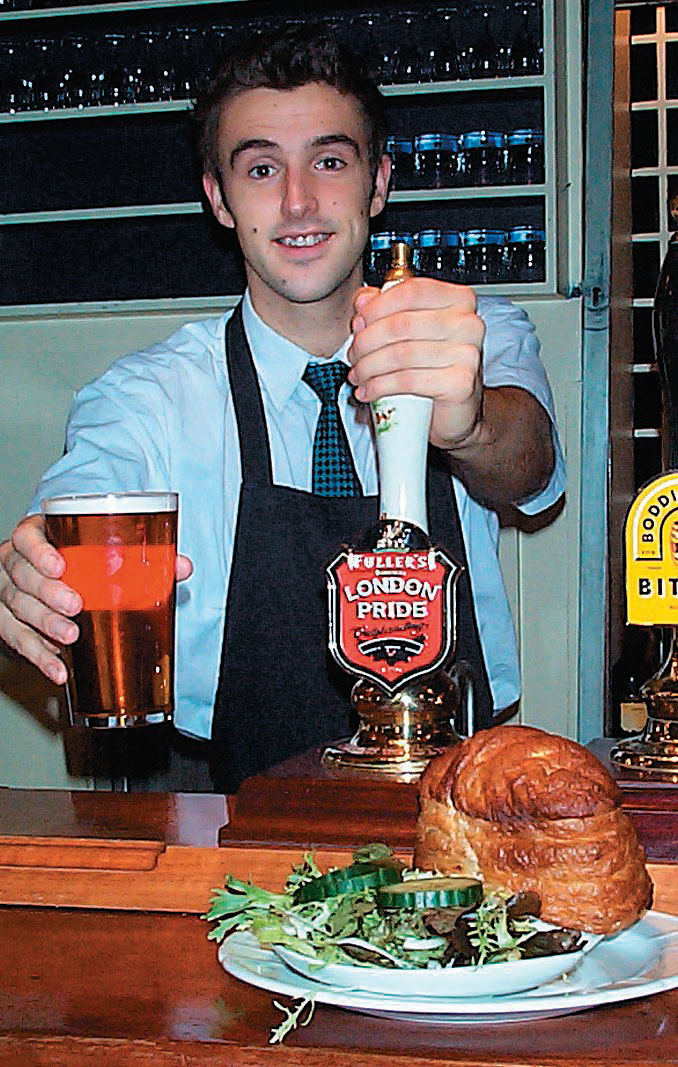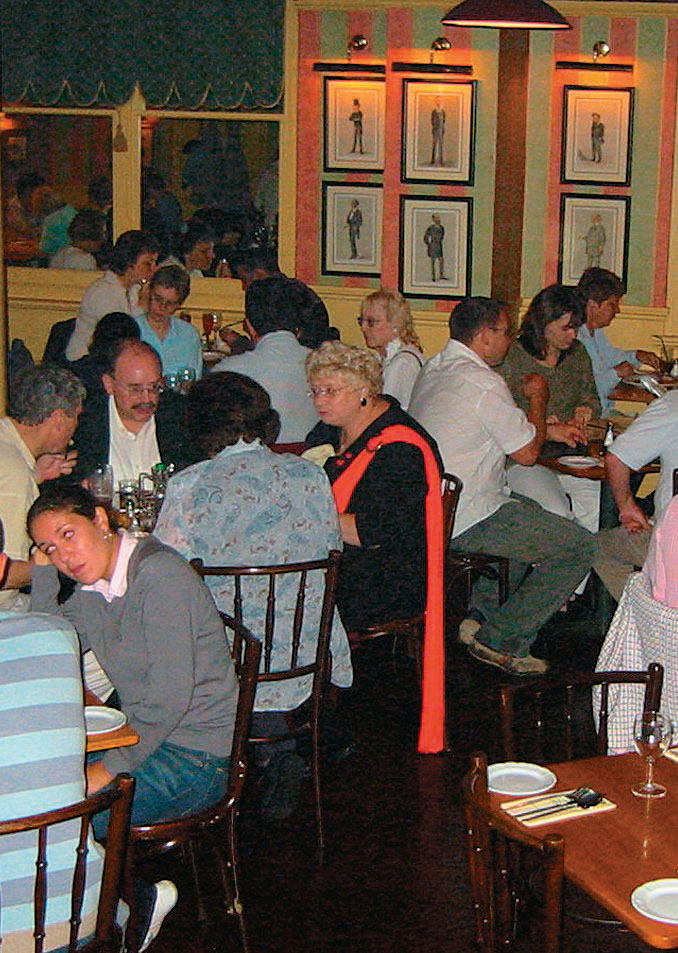
Proper English Fare at Porters
IF PORTERS ENGLISH RESTAURANT had been in business during his lifetime, perhaps the novelist and playwright W.Somerset Maugham would have reconsidered his assertion that “to eat well in England you should have breakfast three times a day.” The secret to good English food, according to Richard Bridgeman, 7th Earl of Bradford and owner of Porters, is “stewing and braising.” He is adamant that if these cooking methods are done correctly with quality ingredients, the result will be very good cuisine.
Porters opened on June 19, 1979, at No. 17 Henrietta St. in the London neighborhood of Covent Garden. This area had been the site of the largest fruit and vegetable market in England for some 300 years. When the market relocated beyond central London in 1973, Covent Garden was left with empty market buildings and numerous vacant premises. Planners wanted to knock down most of the area and create new through roads, hotels and conference centers, but local residents waged a strong campaign against that scheme, and the market was transformed and renovated into the lively hub of entertainment and culture that it is today. The transformation of Covent Garden in 1978 saw the large, glass-covered building that had been designed by Inigo Jones in 1632 turned into a hive of arcades with fashionable shops and bustling stalls under the name Apple Market. Even today Covent Garden retains many of its small cobblestone streets and its quaint alleys and passages.
Bridgeman opened Porters just as Covent Garden was undergoing this brilliant renewal. He laughs heartily at the fact that so many people insist on putting an apostrophe in the name of the restaurant believing that “Porter” refers to a person. The trademark logo of Porters English Restaurant is that of the longgone Covent Garden runner (porter) going about the market with the famous basket holding fruits and vegetables upon his head. A jolly sign depicting this symbol adorns the outside of the restaurant and makes for a warm welcome to those going up and down the street.
[caption id="HistoricLondonDining_img1" align="aligncenter" width="678"]

Courtesy of Porters
[caption id="HistoricLondonDining_img2" align="aligncenter" width="678"]

Courtesy of Porters
Throughout its history, many interesting figures have played a part in the area that is Covent Garden. The owner of Porters is just such a character, in the best sense of the word. Bridgeman enters his office within the premises with collegiate panache, stretches his legs so that his shoe-clad feet rest on the desk, and immediately launches into a string of delightful and interesting tales about his past and his restaurant, progressing on to his views about world events. Dialects seem to come easily to Bridgeman, and his stories come alive as he switches from one accent to another to emphasize each story.
Porters English Restaurant focuses on pies, with its steak, Guinness and mushroom pie the overwhelming menu favorite. At £10.95 it is also a great bargain. All pies come served with a choice of fresh vegetables, a side salad or potatoes in various styles. Lighter fare such as roast chicken and grilled salmon are on the Porters menu as well, although it is the rich pies that make this restaurant special and give it its reputation for good traditional English food.
The desserts at Porters are particularly intriguing and mouthwatering; these days it is difficult to find such items as spotted dick—a steamed suet sponge with sultanas—or steamed syrup sponge, which is one of Porters’ most popular puddings. Another favorite is dark chocolate chip pudding, made with steamed chocolate sponge, chocolate chips and chocolate custard. Everything served at Porters is made on the premises, including the ice cream.
The restaurant has several dining rooms and a bar. Its wood tables and comfortable chairs offer a clublike atmosphere that is inviting, warm and intimate, though some 200 diners can be served at one time. Surprisingly for an area crowded with tourists, about 75 to 80 percent of its clientele are English. In the world of restaurants, the chefs and directors move about a lot, but at Porters the staff seems to stay put. The head chef has been with the restaurant all 26 years, while three senior staff members have been with Porters a total of 50 years between them.
A visit to Porters must always include a thorough exploration of the streets and sights of Covent Garden. Across Henrietta Street is a marked entrance to the delightful little churchyard garden that sits outside St. Paul’s, known as the “Actors’ Church” because of its long association with the theater community. The church’s connections to theater began as early as 1663 with the establishment of the nearby Theatre Royal, Drury Lane, where today the hot musical The Producers plays to packed houses. More theaters followed: In 1732 the Covent Garden Theatre opened, which became the Royal Opera House in 1892. Many famous actors are buried or commemorated within St. Paul’s. Plaques adorn the church walls in remembrance of generations of actors, including tributes to Boris Karloff, Charlie Chaplin, Vivien Leigh and Laurence Olivier.
The secret to good English food, according to Lord Bridgeman, is ‘stewing and braising.’
The famous portico of St. Paul’s is on the west side of the piazza and is instantly recognizable as the site of the opening scene in George Bernard Shaw’s Pygmalion, published in 1912, which became the musical My Fair Lady in 1958. Outside this portico, the fictional Professor Henry Higgins and Eliza Doolittle met for the first time. In his famous diaries, Samuel Pepys wrote about a visit to the piazza, where he saw the first London production of a Punch and Judy show in 1662. At the far corner of the piazza are the Theatre Museum, which chronicles the performing arts in Britain from the 16th century to the present, and the London Transport Museum, whose exhibitions explain the capital city’s transport heritage.
[caption id="HistoricLondonDining_img3" align="aligncenter" width="860"]

Courtesy of Porters
In the revitalized Covent Garden neighborhood, Porters is a fixture. During its more than 25 years of business, the restaurant, as stated on its Web site (www.porters.uk.com), has used enough lettuce to fill all 32 pods of the popular London Eye. It has served a length of sausage that could draw a line from Covent Garden northwest to the university town of Oxford, about 50 miles away. The mission of the restaurant has always been to provide decent traditional English food at reasonable prices. Porters English Restaurant has been doing that for the last quarter of a century and seems certain to continue on into the future. In his own words, Bridgeman says, “It serves the sort of food that you might have hoped to have in a traditional London pub but got lasagna instead.”





Comments